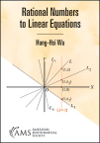- About MAA
- Membership
- MAA Publications
- Periodicals
- Blogs
- MAA Book Series
- MAA Press (an imprint of the AMS)
- MAA Notes
- MAA Reviews
- Mathematical Communication
- Information for Libraries
- Author Resources
- Advertise with MAA
- Meetings
- Competitions
- Programs
- Communities
- MAA Sections
- SIGMAA
- MAA Connect
- Students
- MAA Awards
- Awards Booklets
- Writing Awards
- Teaching Awards
- Service Awards
- Research Awards
- Lecture Awards
- Putnam Competition Individual and Team Winners
- D. E. Shaw Group AMC 8 Awards & Certificates
- Maryam Mirzakhani AMC 10 A Awards & Certificates
- Two Sigma AMC 10 B Awards & Certificates
- Jane Street AMC 12 A Awards & Certificates
- Akamai AMC 12 B Awards & Certificates
- High School Teachers
- News
You are here
Rational Numbers to Linear Equations

Buy Now:
Publisher:
AMS
Publication Date:
2020
Number of Pages:
402
Format:
Paperback
Price:
50.00
ISBN:
978-1-4704-5675-7
Category:
Textbook
[Reviewed by , on ]
BIll Satzer
03/15/2021
See our reviews of Algebra and Geometry and Pre-Calculus, Calculus, and Beyond.
This is the first volume in a set of three that is designed to present an exposition of mathematics in grades 9-12 that is, at the same time, mathematically correct and still appropriate for the grade level. The primary intended readers are K-12 teachers, but the book may also be of interest to education professionals.
This volume together with its two companions has been devised to provide the mathematical content and knowledge that the author believes is needed for teachers and for education faculty who do research. The books are presented with the hope that they will help revamp the mathematical education in universities of pre-service teachers of mathematics and provide a detailed blueprint for textbook publishers for how to introduce mathematics in new school textbooks.
The author is driven by his conviction that mathematics education has declined over the last five decades, and that K-12 mathematics teachers are finding themselves in the untenable position of teaching from a position of weakness since they do not have the necessary knowledge to carry out their job. He argues that there are principles of mathematical integrity that need attention: that every concept has a clear definition; every statement is precise; every assertion is supported by reasoning; and that the development is coherent and has a clear purpose.
Three major parts of the book describe how the author proposes to make this work in practice. He begins with an extensive treatment of fractions and rational numbers, and briefly considers the Euclidean algorithm in the context of division-with-remainder and factorization of integers. He then introduces the basic elements of Euclidean geometry, and finally tackles symbolic notation and equations of lines.
The author is particularly concerned about the teaching of fractions. He argues that the customary treatment is fragmentary and incoherent, and that it means that many students come to high school with a very defective concept of fractions. Accordingly, he brings in the idea of rational numbers early, introduces the number line, and provides an informal discussion of fractions followed by a formal definition.
In the discussion of geometry two fundamental pairs of concepts are described: basic isometries and congruence, followed by dilation and similarity. This approach focuses on concepts and moves away from the mechanical proofs-in-two-column format. The goal is to nurture students’ abilities to formulate and present mathematically correct arguments.
Finally, the author takes up symbolic expressions and linear equations. He proposes that teaching students to be fluent and correct in their use of symbols is critical to their future success with mathematics. He also feels that the idea of slope has been taught very poorly by traditional methods and only succeeds at confusing students.
Occasional “pedagogical comments” are provided throughout the text, but the author does not otherwise get into the details of how this material should be presented in the classroom.
One of the book’s considerable strengths is the author’s coherent approach to the topics that new teachers should master. What doesn’t work as well is the extent to which the discussion focuses on the deficiencies of older ways of teaching the material. Surely new teachers would be best served by emphasis on the new approach that the author proposes.
Bill Satzer (bsatzer@gmail.com), now retired from 3M Company, spent most of his career as a mathematician working in industry on a variety of applications. He did his PhD work in dynamical systems and celestial mechanics.
See the publisher's website.
- Log in to post comments




